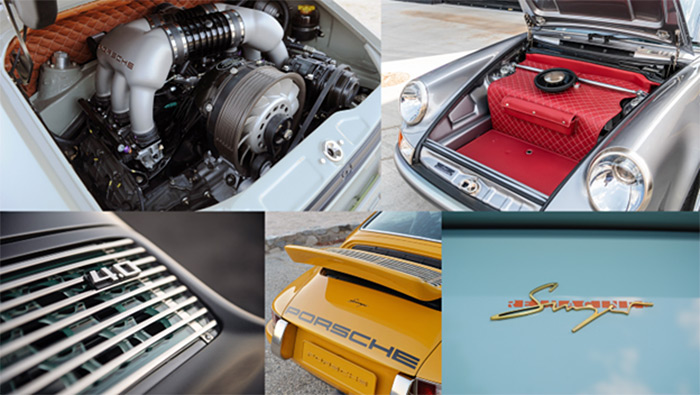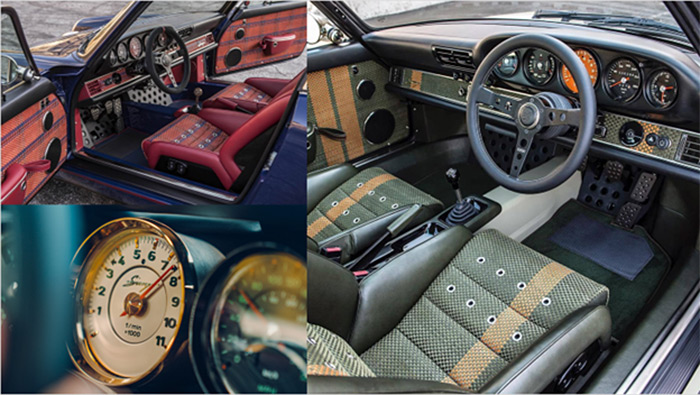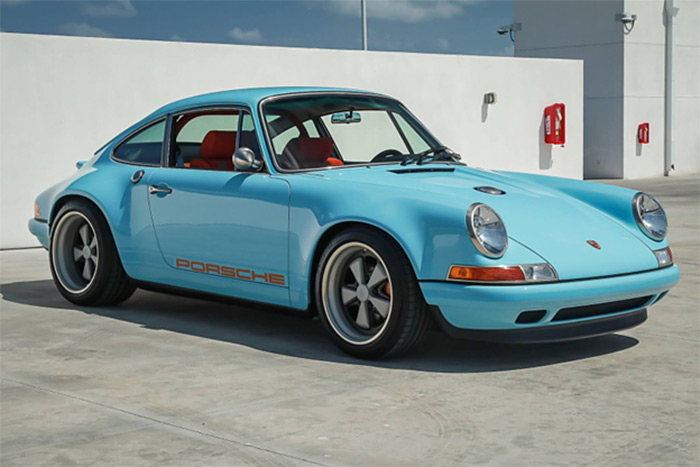Since I started writing about cars semi-professionally, there’s been one splinter I’ve been unable to get out of my frontal cortex. Through hundreds of published stories here, there, and elsewhere, it has haunted me. A change in point of view this week turned out to be the missing piece I’ve been looking for. The premise? How someone would go about “Singer-izing” America’s most iconic vehicle – the one and only Chevrolet Corvette.
Singer 101
Before getting into my solution, here is some background for those who might not have heard of California’s greatest modern export, Singer Vehicle Design’s “Reimagined” Porsche 911. Back in 2009, with the stated goal of modernizing the iconic 964-generation (1989-1994) Porsche 911 for the 21st century, SVD set about creating the ultimate air-cooled driving experience wrapped in a perfected 911 silhouette.
The proprietary process that resulted from this goal now begins by stripping a – traditionally rough around the edges but mechanically sound – base 964 to the studs. When the media-blasted metal of the roof, pillars, bulkheads, and floor pan are all that remains, Singers-in-progress are seam-welded, strengthened, and treated to a half-cage for maximum structural rigidity. OEM steel doors are then surrounded by exclusive Singer-perfected carbon fiber flares, bumpers, and rockers that all but eliminate the already famously minimal panel gaps before being carefully applied with a flawless coat of whatever paint combination each individual customer desires. Inside and behind the rear axle, the attention to excellence and detail is only elevated from the already-otherworldly standard of the exterior.

It is difficult to do justice to the quality of Singer’s interior with mere written words, but one look at the fine watches it wears for gauges and the rich, soft, tightly-woven, and custom-colored aniline leather/suede of the unique RECARO seats and mainline of the dash should be enough to let you know that these guys are playing in a different orbit than anything you’ve previously experienced. It’s the same story under the beautifully crafted ducktail spoiler, where the car’s quilted leather-lined chest cavity is more akin to a jewelry box than a grubby engine bay. At its center sits a flat-six heart/gem hand-built in the US by Cosworth. It comes in flavors ranging from 3.6L/300 HP to 4.0L/425 HP with an eye-popping 11,000 redline, all based on the 964’s timeless powerplant. It’s hard not to get carried away when discussing art of this magnitude, but this was intended as a quick aside before jumping into today’s actual story, so I’ll close with this: I once dragged the Mrs. two hours to Porsche of Colorado Springs to see a Singer 911 in the metal. Even though it was one of the less creative of their builds, I was still so taken aback by the level of craftsmanship it represented that the 918 Spyder parked next to it might as well have been a Jetta.
Where Would You Start with a Singer Corvette?
With its reimagination, Singer used a common gripe of the 911 to its advantage. Since its debut in 1964, Porsche hasn’t drastically altered the appearance of its bread-and-butter sports car. This allowed Singer to take 20-30-year-old (read modern, but not cutting-edge) examples and update them with the best present-day materials and engine-building techniques while also slathering them with ‘60s-style and vintage appeal with nothing more than bumper-swap and a recommended classic color palette. The most difficult part of doing a similar project with America’s Sports Car is that each of its eight generations is so drastically different than the one that preceded it. Getting the same ’60s look is where your author had been spinning his wheels for years. I thought the only acceptable donor car was the most iconic ‘Vette, the Mid-Years of 1963-67. Such a project would require more of a full rebuild/resto-mod approach that doesn’t really mesh with the ideals that make Singer’s creations so special. They didn’t just choose the 964 for its looks or the low-entry price of a base car (at the time); in Porsche circles, that generation is heralded as a high watermark for driving dynamics and ultra-communicative steering and the itching feeling that modern 911s had perhaps lost a step in these categories was the primary motivation behind the creation of Singer’s signature product.

To get the same kind of canvas in Corvetteland would necessitate a reconsideration on my part. The best-driving Corvettes are much newer than the original Sting-Ray and also happen to be nearing their 20th birthday, just like the 964 was when Singer started perfecting its blueprint. It’s the 2005-13 C6 and its Z06 counterpart – especially early examples – that I landed on as the ideal starting point for a “Singer’d” ‘Vette. These two easy-to-source machines bring now-defunct but enthusiastically superior tech like hydraulic steering and six-speed manual transmissions to the table. The Z also adds aluminum construction to the mix, while base cars benefit from a crowd-pleasing Targa top. Now, with a C6 starting point, we’ve got to throw out the old-school-cool aesthetic of our inspiration and, instead, go for a “what if these cars were built today?” overhaul.
The Upgrades
To drive these cars is, in a word, fantastic, but they’ve always come with some significant “buts” where we can focus our reimagining. The interior, including electronics and the infamous La-Z-Boy thrones, is in desperate need of a floor-up rebuild – I’d leave the details to a designer, but some kind of a cross between Singer’s work and the current C8’s modern motif is what I have in mind. Standard cars also need the wide-body treatment, so we’d have our own fender panels, but we need to tread carefully with body kits/ fascia treatments as achieving a clean, non-kit car look is our highest priority. We’d also call up the guy who oversaw the original C6 for a new set of carbon wheels, fit the latest version of Mag-ride (we also know a guy who might be available to complete this task), and toss the leaf springs for starters.
Motivators are where things get really interesting, and I already have two vendors in mind. For starters, we don’t need to look any further than Chevrolet’s own collection of crate engines. The LS376/525 that, true to its name, makes 525 horses with 6.2L of displacement would be an ideal standard engine. Katech and its roots with Corvette Racing make it the perfect supplier for customers looking to get a little more oomph out of their comprehensively upgraded and updated C6. While I like the idea of all-new engines, why throw out something that already has almost everything an enthusiast could want? Depending on the model and state of the donor ‘Vette, the Michigan-based super tuner can bolster existing powertrains – their LS3 package, for instance, unlocks 550 HP. They can also do LS7s to the same specification or take them all the way to 640-675 horses – all without resorting to the use of forced induction! The pièce de résistance on our motor menu, though, would have to be the firm’s 427-cube LT1-based “Street Attack” V8 crate engine that makes 700 HP and 626 lb.ft. all while remaining naturally aspirated! Throw in the entirety of the Corvette’s paint back catalog, and you’ve got the makings of something exceptional, but I’m still left wondering…
Would it Sell?
The biggest snag in this master plan is Chevrolet itself. With the all-time great status of the Corvette on showroom floors today, it remains to be seen if anyone out there would actually pay for a C6-as-art build of their own creation. It is certainly a tough sell when they have a decent chance of getting a 670-horse (not to mention whatever 800+ number the ZR1 is about to drop on us!) beast from the factory just by visiting one of our sponsoring dealerships, likely for less money than an all-out reimagining, to boot. After considering all variables, this project might still be a few years away from profitability. The only thing standing between us and levee breaking wall of cash is the continued use of internal combustion power in new versions of America’s Sports Car – the second the C9 goes all-electric, we (or, more likely, someone with the proper funding to pull it off) will be sitting on a proverbial gold mine, as hinted by the the word “almost” being added to the title of this piece after the fact! What say you, Corvette Nation? Would you get in line for a Singer C6, or do you have another pathway to a reimagined Corvette in your mind?
Related:
Now that AWD is Available, Will Corvette Enter the Hot New Off-Road Sportscar Market?
After Singer Porsches gained a following for updating older models with updated engines and materials, could the same kind of styling and upgrades be applied to say, the C6 Corvette? Alex imagines what that might entail.
Car and Driver Picks Slower, More Expensive Porsche 911 GT3 Over the Corvette Z06
-


![[VIDEO] Is This the Purple That GM Should Have Made for the 2025 Corvette? There's been a lot of opinions about the new Hysteria Purple Metallic revealed for 2025, but the owner of this wrapped Purple Corvette Z06 thinks his is way better than the factory offering. What do you think?](https://www.corvetteblogger.com/images/content/uploads/2024/04/042724_7-218x150.jpg)
![[VIDEO] CorvetteBlogger Joins Drive 615 to Show Off What’s New for 2025 [VIDEO] CorvetteBlogger Joins Drive 615 to Show Off What's New for 2025](https://www.corvetteblogger.com/images/content/uploads/2024/04/042724_5-218x150.jpg)

A big block custom wide body 68 – 72 Coupe would be my choice for a Singer Corvette.
Personaly i would think of a C4 as a Singer candidade…..just take a step back and look at the overal car ….. cleand out interior lightend chassis carbon skin ….even the old L98 has enough pottential….to make it a real fun driving experience…..
Alex, you just described the C6 Grand Sport optioned with the 6 speed manual, and therefore the dry-sump, hand built, LS3.
Which is exactly what I own, a 2013 example, and for the specific reasons you delineate.
My engine was hand built by none other than one time Wixom GM experimental engine assembly team leader Chuck DeKubber. Does that give it a little more power than the OE spec 428 Lb/Ft, 436HP with the NPP open exhaust? I don’t know, but it sure feels like it.
Even if it doesn’t 428 Lb/Ft, 436HP with the NPP open exhaust is very satisfying!
Granted, my GS has the steel frame rather than the aluminum, but I’m ok with that, and for good reason, with an acute sense for the obvious.
Why is one of the ugliest cars ever built on this site ?
Are things so bad that this site needs to push a super sport beetle on a corvette site?
Comments are closed.